
Statement of Responsibilities
This document is for use by experienced and trained Qualified Cleveland Range, LLC Authorized Service
Representatives who are familiar with both the safety procedures, and equipment they service.
Cleveland Range, LLC assumes no liability for any death, injury, equipment damage, or property damage
resulting from use of, improper use of, or failure to use the information contained in this document.
Cleveland Range, LLC has made every effort to provide accurate information in this document, but
cannot guarantee that this document does not contain unintentional errors and omissions.
The information in this document may be subject to technical and technological changes, revisions, or
updates.
Cleveland Range, LLC assumes no liability or responsibility regarding errata, changes, revisions, or
updates.
Qualified Cleveland Range, LLC Authorized Service Representatives are obligated to follow industry
standard safety procedures, including, but not limited to, OSHA regulations, and disconnect / lock out /
tag out procedures for all utilities including steam, and disconnect / lock out / tag out procedures for gas,
electric, and steam powered equipment and / or appliances
All utilities (gas, electric, water and steam) should be turned OFF to the equipment and locked out of
operation according to OSHA approved practices during any servicing of Cleveland Range equipment
Qualified Cleveland Range, LLC Authorized Service Representatives are obligated to maintain up-to-date
knowledge, skills, materials and equipment.

Cleveland Range, LLC
1333 East 179th St., Cleveland, Ohio, U.S.A. 44110
Ph: 1-216-481-4900 Fx: 1-216-481-3782 Visit our Web Site at www.clevelandrange.com



CLEVELAND RANGE COMBI CCG
X
SEQUENCE OF OPERATIONS
STEAM MODE
When using these instructions refer to the CCGX wiring schematic for the appropriate model
.
1. To turn the unit on, place the selector switch (B1) in the steam mode.
• Selector switch (B1) contacts A and 1 and contacts B and 2 close. Power is at the
contacts of the clockwise contactor (CD) and counter clockwise contactor (CS).
• 110 VAC is supplied to the primary side of the step-up autotransformer (AT) and
approximately 220 VAC is produced on the secondary side.
• From the transformer (AT), power is sent through both of the motor thermal-protection
contacts (A1 and A2), the chamber high limit (F2), and the boiler high limit (F3).
• The relay board (SC) is then energized as well as the power pilot light (H1).
• The cooling fan (M2) is energized and the system waits until either the door switch or
the drain valve is closed.
2. Pressing the drain switch located on the front control panel closes the drain valve.
• When the drain valve (V1) is closed, power is sent to the water level control (PL). At
this time if the probes, located in the top of the generator, are not grounded, the fill
solenoid valve (S2) is energized and the unit fills with water until the high probe is
grounded.
• While in use, the water level control (PL) will energize the fill solenoid valve (S2)
whenever the water level drops below the high probe.
3. When the door is closed, the door-switch (B3) closes.
• The coil to the door switch relay (RM) is energized closing the contacts (21 and 24)
sending power to the meat probe switch (IS).
4. When the meat probe (IS) is not selected the power is sent to the timer (B8).
5. With time on the timer (B8), the fan circuit is energized.
• Power is sent to the timer indicator light (H1) and through the selector switch (B1)
closed contacts D and 6 to the reversing switch (I).
6. The reversing switch (I) will energize either the clockwise contactor coil (CD) or the counter
clockwise coil (CS).
• In approximately 3 minutes it will energize the other coil, reversing the direction of the
fan. The fan speed relay (RV) is energized at the same time the reversing switch (IS)
has power.
7. With the fan speed switch set on high the high-speed contactor coil (CA) is energized and the
contacts (CA) close, sending power to the fan motor (M) through the thermal protection
(A1).

• With the contactor (CA) closed, power is sent to both the damper system relay (RS)
and the heat circuit through the chamber thermostat (F1).
• The power will remain at the chamber thermostat (F1) until no time is left on the timer
and the buzzer (N) is energized.
8. If the meat probe (SS) is selected the heat circuit is controlled by the temperature set at the
core temperature thermostat (indicated by the dotted lines).
• When the temperature of the product is the same as entered, the buzzer (N) is energized
shutting off the heat circuit.
9. While the heat circuit is energized through the timer (B8) or core temperature thermostat the
chamber thermostat (F1) controls it.
10. With the chamber thermostat (F1) set, power is sent to the heat indicator light (H1) and the
water level control (PL).
• When water reaches the low probe and it is grounded, the water level control (PL) will
send power to the steam thermostat (F4).
• Until the steam thermostat (F4) is satisfied (149 degrees Fahrenheit at the vent pipe)
power will be sent to the Boiler relays (RB1 and RB2), closing the RB1 and RB2
contacts.
• This will energize the boiler ignition module (Z2). After the surface igniter, located
above the burner in the boiler burner chamber, has been energized for 4.5 seconds the
ignition module (Z2) energizes the main valve coil of the gas valve (S4).
• The timer (TE) is energized and after 8 seconds the HI coil of the gas valve is
energized from the timer (TE).
• The burner circuit will remain energized until the unit cycles.
11. The condensate solenoid (S5) is controlled by the condensate thermostat (F5).
• When the temperature in the drain exceeds 158 degrees Fahrenheit it closes and the
condensate solenoid (S5) is energized.







-
 1
1
-
 2
2
-
 3
3
-
 4
4
-
 5
5
-
 6
6
-
 7
7
-
 8
8
-
 9
9
-
 10
10
-
 11
11
-
 12
12
-
 13
13
Cleveland CombiCraft CCG-210X Specification
- Type
- Specification
- This manual is also suitable for
Ask a question and I''ll find the answer in the document
Finding information in a document is now easier with AI
Related papers
-
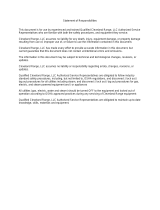 Convotherm CCE106 Obsolete 2005 Specification
Convotherm CCE106 Obsolete 2005 Specification
-
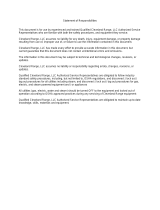 Cleveland CombiCraft CCE-210X Specification
Cleveland CombiCraft CCE-210X Specification
-
Cleveland SteamCraft Power 10 User manual
-
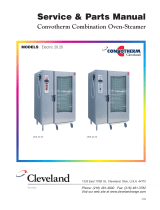 Cleveland Convotherm OEB-20.20 User manual
Cleveland Convotherm OEB-20.20 User manual
-
Cleveland Convotherm OEB-6.10 User manual
-
Cleveland Convotherm OEB-6.10 User manual
-
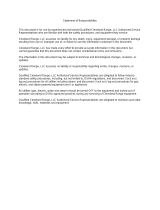 Cleveland 24CGA10 User manual
Cleveland 24CGA10 User manual
-
Cleveland Classic Electric Boiler Base User manual
-
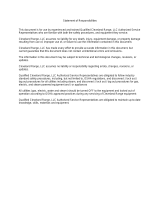 Cleveland 24-CGM-200 Supplementary Manual
Cleveland 24-CGM-200 Supplementary Manual
-
Cleveland 24-CSM User manual
Other documents
-
Cleveland Range 24-CGA-10 User manual
-
Cleveland Range 24-CEM-48 User manual
-
Cleveland Range 21-CET-8 User manual
-
Cleveland Range 24-CEA-10 User manual
-
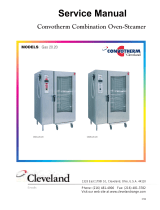 Convotherm OGB 20.20 User manual
Convotherm OGB 20.20 User manual
-
Cleveland Range 2DQTLLE User manual
-
Cleveland Range 2DS User manual
-
Groen (2)CC20-EF User manual
-
Cleveland Range 24-CSM User manual
-
Cleveland Range 21-CGA-5 User manual


















